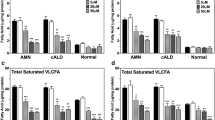Abstract
In its severe form, X-linked adrenoleukodystrophy (X-ALD) is a lethal neurodegenerative disorder with inflammatory demyelination, in which defective peroxisomal β-oxidation causes accumulation of very long-chain fatty acids (VLCFA) in tissues and plasma, in particular in the nervous system and adrenal glands. Recently, several drugs have been reported to reduce VLCFA in cultured human fibroblasts of X-ALD patients, and therefore to be potential candidates for novel therapeutic treatments in X-ALD. Among the most promising of these substances is the antidepressant rolipram, because of favourable adverse event profile in clinical studies and its additionally reported anti-inflammatory action. To further elucidate the effects of rolipram on peroxisomal β-oxidation and VLCFA accumulation, we administered rolipram orally in the diet to ALD protein-deficient mice and ALD protein-deficient cultured human and mouse fibroblasts and assayed the accumulation of VLCFA. In contrast to the previously reported reduction of VLCFA, our data did not demonstrate a decrease in VLCFA content either in vivo or in vitro. NMR spectroscopic analysis verified the structural integrity and purity of the rolipram used here, thus excluding inauthenticity as a reason for the discrepancy. We therefore suggest that rolipram should be excluded from the current list of potential therapeutic agents for X-ALD.
Similar content being viewed by others
REFERENCES
Amsterdam A, Zauberman A, Meir G, Pinhasi-Kimhi O, Suh BS, Oren M (1988) Cotransfection of granulosa cells with simian virus 40 and Ha-RAS oncogene generates stable lines capable of induced steroidogenesis. Proc Natl Acad Sci USA 85: 7582–7586.
Angel JB, Saget BM, Walsh SP, et al (1995) Rolipram, a speci¢c type IV phosphodiesterase inhibitor, is a potent inhibitor of HIV-1 replication. AIDS 9: 1137–1144.
Aubourg P (1996) X-linked adrenoleukodystrophy. In Moser HW, ed. Handbook of Clinical Neurology, vol. 22. Amsterdam: Elsevier, 447–483.
Braiterman LT, Watkins PA, Moser AB, Smith KD (1999) Peroxisomal very long chain fatty acid b-oxidation activity is determined by the level of adrenoleukodystrophy protein (ALDP) expression. Mol Genet Metab 66: 91–99.
Fleischhacker WW, Hinterhuber H, Bauer H, et al (1992) A multicenter double-blind study of three dif-ferent doses of the new cAMP-phosphodiesterase inhibitor rolipram in patients with major depressive disorder. Neuropsychobiology 26: 59–64.
Folch J, Lees M, Sloane-Stanley GH (1957) A simple method for the isolation and puri¢cation of total lipids from animal tissues. J Biol Chem 226: 497–509.
Forss-Petter S, Werner H, Berger J, et al (1997) Targeted inactivation of the X-linked adrenoleukodystrophy gene in mice. J Neurosci Res 50: 829–843.
Hebenstreit GF, Fellerer K, Fichte K, et al (1989) Rolipram in major depressive disorder: result of a double-blind comperative study with imipramin. Pharmacopsychiatry 22: 156–160.
Kasyapa CS, Stentz CL, Davey MP, Carr DW (1999) Regulation of IL 15-stimulated TNF-a production by rolipram. J Immunol 163: 2836–2843.
Kemp S, Wei HM, Lu JF, et al (1998) Gene redundancy and pharmacological gene therapy: implications for X-linked adrenoleukodystrophy. Nature Medicine 11: 1261–1268.
Kim DH, Lerner A (1998) Type 4 cyclic adenosine monophosphate phosphodiesterases as a therapeutic target in chronic lymphocytic leukemia. Blood 92: 2484–2494.
Moser HW, Moser AB (1991) Measurements of saturated very long chain fatty acids in plasma. In Hommes FA, ed. Techniques in Diagnostic Human Biochemical Genetics. New York: Wiley-Liss, 117–191.
Moser HW, Smith KD, Moser AB (1995) X-linked adrenoleukodystrophy. In Scriver CR, Beaudet AL, Sly WS, Valle D, eds. The Metabolic and Molecular Bases of Inherited Disease. New York: McGraw-Hill, 2325–2349.
Mosser J, Douar AM, Sarde CO, et al (1993) Putative X-linked adrenoleukodystrophy gene shares unexpected homology with ABC transporters. Nature 361: 726–730.
Navikas V, Matusevicius D, Soderstrom M, Pirskanen R, Fredrikson S, Link H (1998) The phosphodiesterase IV inhibitor rolipram in vitro reduces the number of MBP-reactive IFN-and TNF-mRNA expressing blood mononuclear cells in patients with multiple sclerosis. Clin Neuropharmacol 21: 236–244.
Netik A, Forss-Petter S, Holzinger A, Molzer B, Unterrainer G, Berger J (1999) Adrenoleukodystrophy-related protein can compensate functionally for adrenoleukodystrophy protein de¢ciency (X-ALD): implications for therapy. Hum Mol Genet 8: 907–913.
Pahan K, Khan M, Singh I (1998) Therapy for X-adrenoleukodystrophy: normalization of very long chain fatty acids and inhibition of induction of cytokines by cAMP. J Lipid Res 39: 1091–1100.
Scott AIF, Perini AF, Shering PA, Whalley LJ (1991) In-patient major depression: is rolipram as e¡ective as amitryptiline? Eur J Clin Pharmacol 40: 127–129.
Sekut L, Yarnall D, Stimpson SA, et al (1995) Anti-in£ammatory activity of phosphodiesterase (PDE)-IV inhibitors in acute and chronic models of in£ammation. Clin Exp Immunol 100: 126–132.
Singh I, Pahan K, Khan M(1998a) Lovastatin and sodium phenylacetate normalize the levels of very long chain fatty acids in skin ¢broblasts of X-adrenoleukodystrophy. FEBS Lett 426: 342–346.
Singh I, Khan M, Key L, Pai S (1998b) Lovastatin for X-linked adrenoleukodystrophy.NEnglJMed 339: 702–703.
Sommer N, Loschmann PA, Northo¡ GH, et al (1995) The antidepressant rolipram suppresses cytokine production and prevents autoimmune encephalomyelitis. Nature Medicine 1: 244–248.
Turner CR, Andresen CJ, Smith WB, Watson JW (1994) E¡ects of rolipram on responses to acute and chronic exposure in monkeys. Am J Respir Crit Care Med 149: 1153–1159.
Wachtel H (1990) The second-messenger dysbalance hypotheses of a¡ective disorders. Pharmacopsychiatry 23: 27–32.
Watkins PA, Gould SJ, Smith MA, et al (1995) Altered expression of ALDP in X-linked adrenoleukodystrophy. Am J Hum Genet 57: 292–301.
Author information
Authors and Affiliations
Rights and permissions
About this article
Cite this article
Netik, A., Hobel, A., Rauschka, H. et al. Rolipram does not normalize very long-chain fatty acid levels in adrenoleukodystrophy protein-deficient fibroblasts and mice. J Inherit Metab Dis 23, 615–624 (2000). https://doi.org/10.1023/A:1005686114356
Issue Date:
DOI: https://doi.org/10.1023/A:1005686114356




